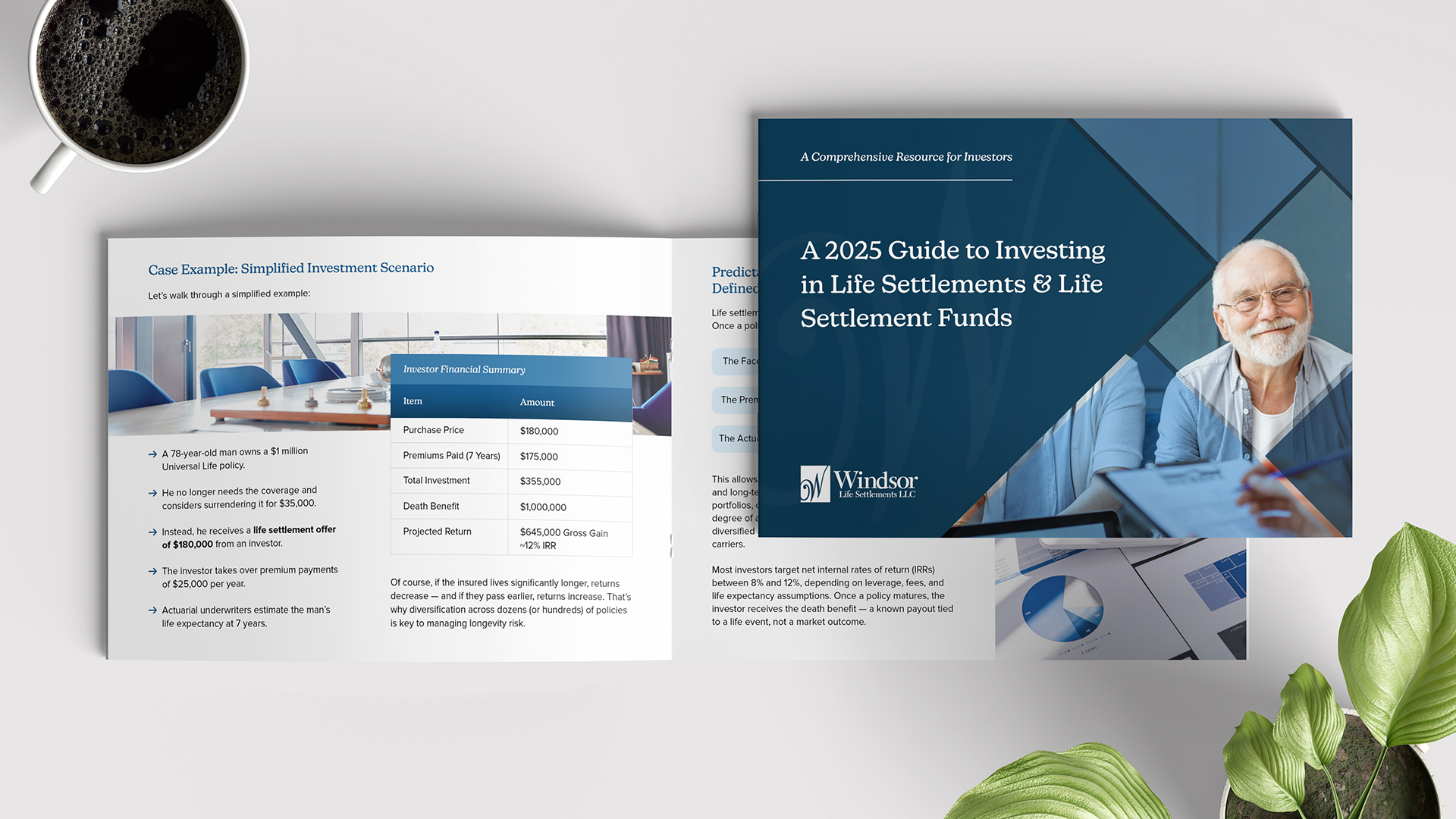
- Author: Windsor Life Settlements
- Published Date:
Chapter One: No Stocks, No Stress: Life Settlements Offer Calm in a Volatile Market
Life settlements are often considered alternative investments. However few investment opportunities combine contractual guarantees, predictable cash flows, and low market correlation like life settlements. Yet for many investors, the mechanics of this asset class remain unfamiliar.
This chapter will break down how life settlements work, how value is determined, the types of policies typically involved, and what every investor should understand before allocating capital to this space.
How Life Settlements Work
At its core, a life settlement is a secondary market transaction: an existing life insurance policyholder — typically a senior — sells their policy to a third party for more than its cash surrender value but less than the death benefit.
Here’s a simple breakdown:
- Policyholders sell their life insurance policy to an investor (or fund) via a licensed provider or broker.
- The investor becomes the new policy owner and is responsible for ongoing premium payments.
- When the insured person passes away, the investor receives the death benefit.
The difference between the purchase price (plus premiums paid) and the death benefit represents the investor’s return.
This arrangement can be a win-win:
- Policyholders can receive immediate liquidity for an unwanted, unaffordable, or unneeded policy — often 3 to 5 times more than the surrender value offered by the insurance company.
Investors gain access to an asset with predictable, actuarially modeled cash flows and returns not tied to market volatility.
Behind the Offer: A Closer Look at How Life Settlements Really Work
The life settlement process follows a structured path involving several key players and regulatory checks:
- Origination
The policyholder (typically aged 65 or older) contacts a broker or provider to explore selling their policy. They must meet certain eligibility criteria: age, health condition, and policy size (usually $100,000+ in face value). - Underwriting and Valuation
Medical records and policy details are collected. Independent life expectancy (LE) underwriters provide actuarial estimates of the insured’s lifespan — typically in months or years. This LE estimate is critical in determining the policy’s present value. - Bidding and Pricing
Brokers may solicit offers from multiple investors or funds. The purchase price is determined by:- The insured’s life expectancy
- Annual premiums due
Face value (death benefit) - Discount rate used by the investor (usually targeting an IRR of 8–12%)
- Sale and Transfer
Upon agreement, the policy is legally transferred to the investor or investment entity. Premium responsibilities shift, and beneficiaries are updated to the new owner. - Servicing and Maturity
The investor (or servicing firm) pays premiums, monitors the policy, and tracks the health status of the insured. When the insured passes, the death benefit is paid to the investor.
Are Life Settlements a Good Investment Opportunity?
Life settlements are best suited for investors with a long-term horizon and a preference for stable, uncorrelated assets. While the market offers strong returns, investors should conduct thorough due diligence, assess policy selection rigorously, and partner with experienced fund managers or brokers to mitigate risks.
The life settlement market has been growing steadily, with increasing participation from institutional investors. The industry is projected to expand as more seniors become aware of this option and as investors recognize the potential benefits.
Some key market trends include:
Aging Population: With the baby boomer generation entering retirement, more individuals are seeking ways to unlock value from their life insurance policies.
Regulatory Support: The life settlement industry is well-regulated in the U.S., providing transparency and protection for both policyholders and investors.
Institutional Adoption: Pension funds, hedge funds, and family offices have increasingly incorporated life settlements into their portfolios.
According to Conning & Co., the life settlement market is expected to grow to $200 billion in the coming years as awareness and investor participation increase (Conning Report, 2023).
Should I Invest in a Life Settlement Fund?
For those new to the asset class, investing through a life settlement fund can be a prudent approach. These funds provide diversified exposure across multiple policies, reducing single-policy risk while leveraging industry expertise to optimize portfolio performance.
Investors can access the life settlement market in two primary ways:
Direct Investments: Purchasing individual policies can provide higher potential returns but requires extensive due diligence, medical underwriting expertise, and risk management.
Life Settlement Funds: These professionally managed funds pool multiple policies, offering investors diversification and reducing individual policy risk. Funds provide a more passive and accessible way to participate in the market.
For most investors, especially those new to the asset class, life settlement funds offer a balanced approach with professional management and risk mitigation. However the benefits of buying policies directly may appeal to the more sophisticated investor.
Final Thoughts
Life settlements present a unique and compelling investment opportunity for those seeking alternative assets with stable, market-independent returns. With a growing, regulated market and a demonstrated track record of strong performance, this asset class is an attractive consideration for sophisticated investors.
Sources:
Wharton School of Business, “The Growing Role of Life Settlements in Institutional Portfolios,” 2021.
Life Insurance Settlement Association (LISA), “Understanding the True Value of Your Life Insurance Policy,” 2022.
Conning & Co., “2023 Life Settlement Market Outlook,” 2023.
- Author: Windsor Life Settlements
- Published Date:
Windsor Life Settlements
Questions? Comments?
We’re available by phone Monday-Friday 9am-5pm CT